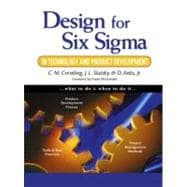
I. INTRODUCTION TO ORGANIZATIONAL LEADERSHIP, FINANCIAL PERFORMANCE, AND VALUE MANAGEMENT USING DESIGN FOR SIX SIGMA.
1. The Role of Executive and Management Leadership in Design for Six Sigma.II. INTRODUCTION TO THE MAJOR PROCESSES USED IN DESIGN FOR SIX SIGMA IN TECHNOLOGY AND PRODUCT DEVELOPMENT.
III. INTRODUCTION TO THE USE OF CRITICAL PARAMETER MANAGEMENT IN DESIGN FOR SIX SIGMA IN TECHNOLOGY AND PRODUCT DEVELOPMENT.
IV. TOOLS AND BEST PRACTICES FOR INVENTION, INNOVATION, AND CONCEPT DEVELOPMENT.
V. TOOLS AND BEST PRACTICES FOR DESIGN DEVELOPMENT.
VI. TOOLS AND BEST PRACTICES FOR OPTIMIZATION.
VII. TOOLS AND BEST PRACTICES FOR VERIFYING CAPABILITY.
The New copy of this book will include any supplemental materials advertised. Please check the title of the book to determine if it should include any access cards, study guides, lab manuals, CDs, etc.
The Used, Rental and eBook copies of this book are not guaranteed to include any supplemental materials. Typically, only the book itself is included. This is true even if the title states it includes any access cards, study guides, lab manuals, CDs, etc.